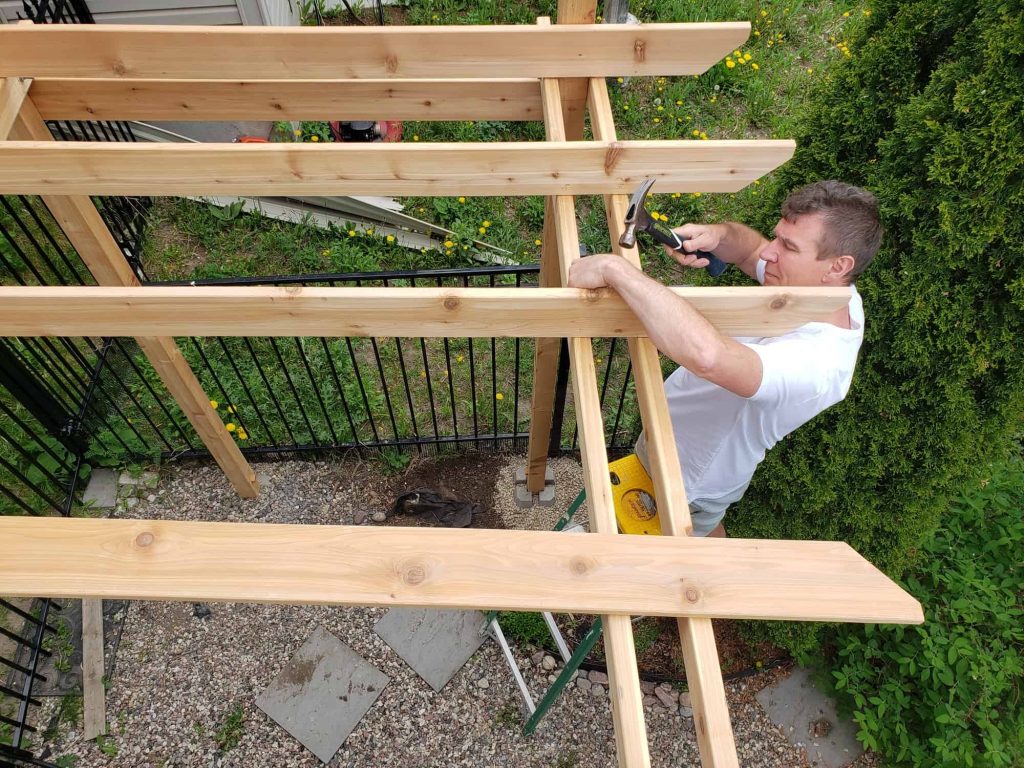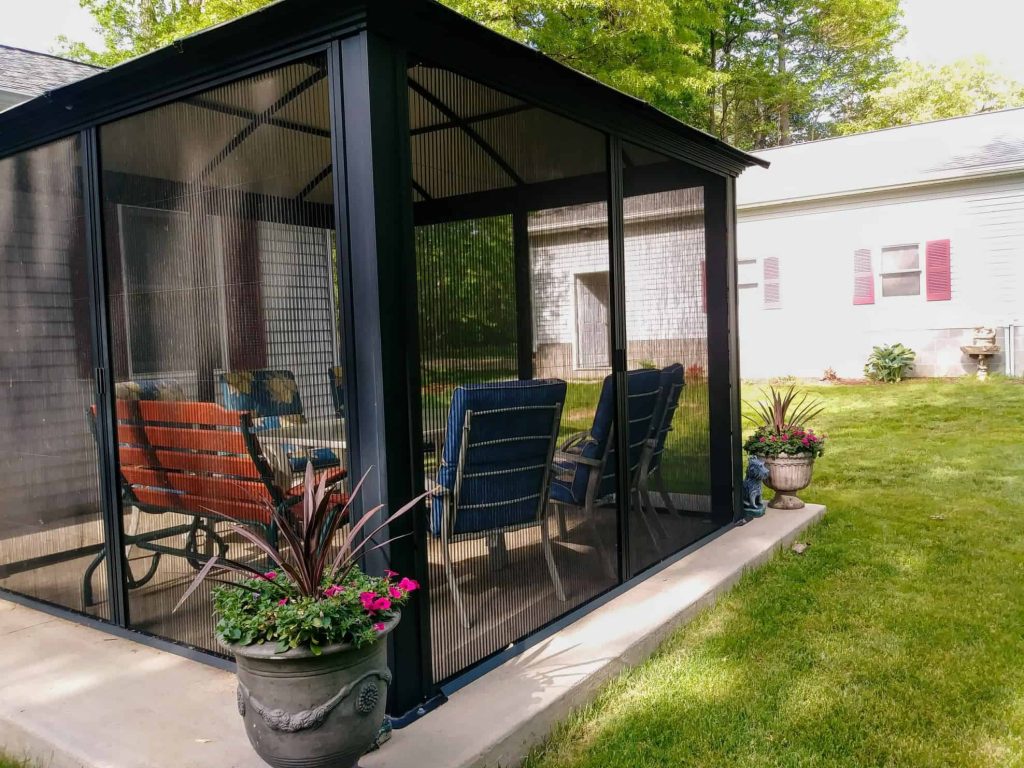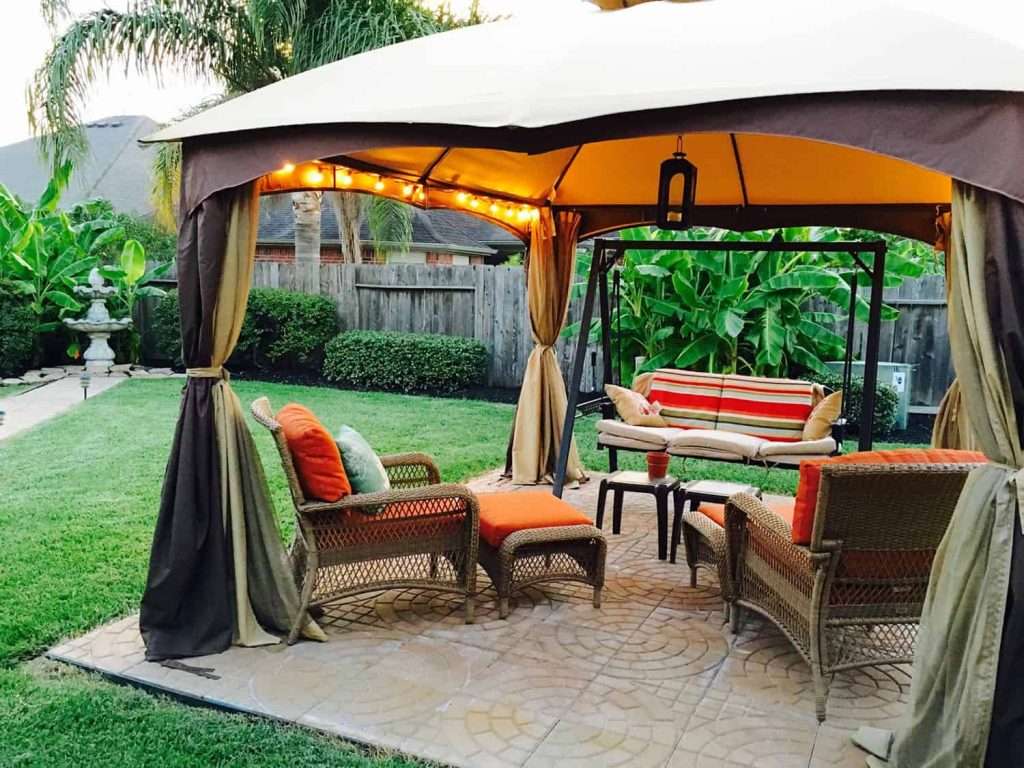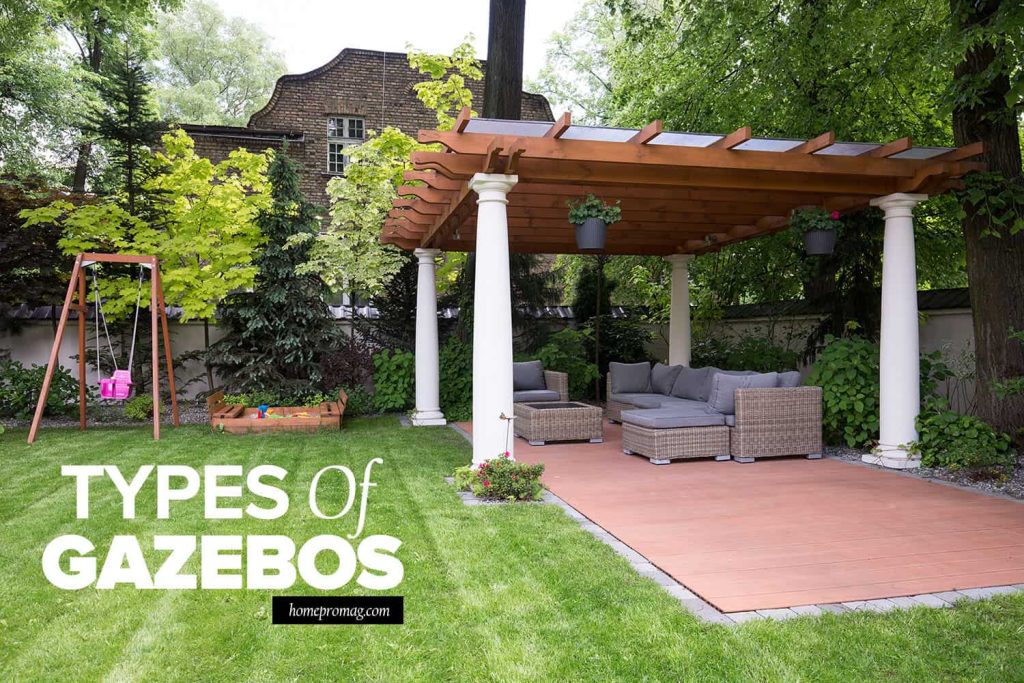The materials that have been used to construct Gazebos are a reflection of the purpose of the Gazebo and the niche the owner has decided to create. The materials used in constructing a Gazebo determine its durability, tenacity against unfavorable weather elements, placement, and purpose of the Gazebos.
Wood, fabric, and metal are the different materials that can be used to construct a Gazebo.
The materials used for them also determine the ease of mobility and storage. There are certain materials that can withstand certain weather elements longer and better than others. As a Gazebo owner or one who intends to own a Gazebo, it is important you are familiar with the varieties of Gazebos available to you so you would know what the best choice for your residence is.
Which is the sturdiest gazebo? Which Gazebo is prone to weather damage and pest infestation? Are there better ways you can maintain your particular type of Gazebos? All of these answers have been provided for you.
Just Before You Erect Your Gazebo
Consider these tips when planning on buying or building a gazebo.
- Ensure a permit is gotten from the local building office before you start constructing or erecting your Gazebo
- Choosing an appropriate location for your gazebo is very important. Choose a location void of trees, wires and pipes. In addition, the location where the gazebo would be situated would inform the size and design of the Gazebo.
- Be clear on the purpose of the Gazebo as this would also inform the design, size and material to be used for the Gazebo.
- Determine if you would buy or construct the Gazebo. Draw a budget and see if you can afford either option.
- For durability and safety, ensure the best materials are used for the Gazebo.
- If your Gazebo would be self-built, ensure you watch a couple of tutorial videos to be familiar with the techniques and materials to be used. Work with an accurate plan before you start erecting the structure. If you face a hurdle in the course of the project, be quick to consult a professional to avoid wasting resources and to fast track the project.
- It is advisable to rent materials rather than purchasing them since it is a one-time project.
- Choose an interior design that suits your fancy.
- Create a cleaning schedule for proper maintenance.
Types Of Gazebos
There are three main types of gazebos and they are:
- Wooden gazebos.
- Metal gazebos.
- Fabric gazebos.
We’ve broken each gazebo type down and highlighted everything you need to know.
1. Wooden Gazebo

With a wooden gazebo, you get to store your furniture without fear of it being damaged by moisture. The natural look and feel that a wooden Gazebo has makes it a common choice for owners. In addition, the wooden Gazebo affords you the opportunity to sculpt any structure that would suit your interest.
Because it is wood, it is very affordable to most. Also, wooden gazebos can be single-handedly built so far the builder gets familiar with the techniques by watching tutorial videos, gets the right equipment, and works with an accurate plan.
If you decide not to DIY it, you could hire a professional to help construct the Gazebo although it is more expensive to hire a contractor than to self-build the Gazebo. They are sturdier than the fabric Gazebo and can be constructed to accommodate more people than other types of Gazebos.
They can be used for sit-outs, barbeque grills, relaxation, and yoga studios.
One major fear that Gazebo owners face is the dilemma of a pest infestation, specifically termite infestation. The fear of a termite infestation is a real one that should not be taken lightly as an infestation can pull down your Gazebo. Termites are the ultimate threats to the durability of your Gazebo.
If your wooden gazebo becomes infested by termites, there are signs you should look out for. Some of the signs are:
- Termite droppings: These droppings are also called wood dust and are usually sand-like. This is one of the first signs of a pest infestation
- Wood damage: Any wood infested by termites can be easily detected. Deep cracks are an indication of the deformity termites can cause in your Gazebo. In addition, they can appear blistered with deep holes filled with termites. Damaged wood is always darker than other parts of the wood.
- Mud tubes: This is a major sign of an infestation that should not be ignored. Mud tubes usually appear on the exterior of your walls or wooden surfaces.
- Termite wings: They’re are also an indication that your Gazebo has been infested. Once termites are ready to move into a new habitation, they shed their wings in preparation for an infestation
- Termite swarming: This is a pointer that your home is about to be or already infested by termites. If you see them gather in a specific location, be quick to use effective pesticides that can wade them off.
The severity of the termite infestation depends on if you notice more than one of the signs.
Another major dilemma that wooden Gazebo owners face is moisture build-up which can lead to rot, mold, and mildew. Protective sealants can be applied annually to reduce the effect of moisture on the wood.
Maintaining A Wooden Gazebo
These are tips you must know before and after constructing your Gazebo.
- Ensure the wood selected for constructing is of good quality. It is better to make use of quality wood than to use inferior wood which would be detrimental in the near future.
- Have a specific purpose for constructing the Gazebo as it would inform the size and design of the structure.
- Choose a location void of wires and pipes. Remember to get a permit before you start constructing.
- Consistently look out for pest infestation especially termites. You don’t have to wait to wait for an infestation to employ preventive measures. Regularly contact a professional to look out for signs of an infestation in order to quickly combat them.
- During winter, avoid snow build up. Moisture weakens the integrity of wood.
- Make use of water resistant wood such as teak, redwood, and bald cypress.
- Avoid pressure washing your Gazebo. pressure washing washes off any protective coat you might have used for your wood and can expose them to easy damage
- Apply protective coatings for the wood to keep wood strong and attractive.
- For a sturdy structure that can withstand storms, make use of anchor kits and gazebo weights.
2. Metal Gazebo

Metal Gazebos are the strongest and the most durable type of Gazebos. Metal Gazebos are the most expensive among other Gazebos but have a longer lifespan than the other options.
You can leave your metal gazebo out all year without fear of it being damaged by weather elements- come rain, come sun, your Gazebo is sure to survive all seasons. A metal gazebo can last up to 15 years if it was constructed with quality materials and if it is properly maintained. All your metal Gazebo needs during a snowstorm are strong anchor kits and beams.
It is important that some Gazebos can have a combination of metal and fabric. The beams and poles would be made of metal but the roof cover would be made of fabric.
Like other types of Gazebos, a major threat to metal Gazebo is moisture which can lead to rust and corrosion. You can prevent rusting to an extent by avoiding water build-up from rain and snow. When rusting occurs, the integrity of the structure is weakened and damage can set in. lookout for cracks, holes, leakages in your roof to know if the metal Gazebo is still as strong.
If the roof cover of your metal Gazebo is made of fabric, you can protect it from moisture damage by employing the use of water-resistant sprays and ensuring the Gazebo is not constructed behind vegetation.
Another dilemma metal Gazebo owners face is lightning and thunderstorms. It is important to know if the vicinity you reside in is prone to thunder and lightning storms. If the metal gazebo is a temporary structure, you could disassemble them during thunderstorms but if it is permanent, ensure it is well-grounded to the floor. To be on the safe side when planning outdoor activities in a Gazebo, watch the weather forecast to know if the likelihood of a thunderstorm is high.
To be protected against lighting, exit your Gazebo immediately after the incidence of a thunder-strike.
To get a sturdy structure, make use of the best materials and ensure they are erected by professionals to avoid mishaps.
Maintaining A Metal Gazebo
So you’re going for the metal gazebo option. Here are some maintenance tips;
- Paint every metallic part of the Gazebo for protective coatings. This reduces the likelihood of rust and maintains its attractiveness.
- Avoid snow build up.
- Regularly check for holes, cracks and leakages in the roof. The gravity of the damage would inform the next line of action. If the damage is beyond your control, seek professional services.
- Check for loosened screws regularly to ensure the structure is always sturdy.
- Use Gazebo frames and weights to support the structure.
- Ensure electrical appliances are properly stored to avoid mishaps such as electrocution.
- Ensure your metal gazebo is always kept clean and tidy.
3. Fabric Gazebo

This is the most portable and cheapest Gazebo. It is your best bet for an emergency sit-out. The fabric gazebo is also referred to as Gazebo canopies. The materials used in making the fabric gazebo cannot withstand certain weather elements.
This is the reason its owners are usually advised to disassemble the Gazebo during winter and rainstorms. Unlike the other types of Gazebos, they are prone to easy damage and are not as durable as the others. A fabric gazebo that is properly maintained would last for a maximum of 4 years.
They are the perfect option for easy mobility but cannot be used all year long. The fabric can be purchased and erected single-handedly as they would come in kits with descriptions on how to assemble them.
Tears and mold are the major challenges for fabric Gazebo. Because the materials are not as strong as wood or metal, they can be easily damaged by weather elements. It is always advisable to take down your gazebo during unfavorable weather conditions.
Mold and mildew occur when the Gazebo canopy is exposed to moisture over time. With proper storage and maintenance, you can always protect your Gazebo from mildew and mold. In addition, they can easily be combatted.
Maintaining A Fabric Gazebo
Maintaining a fabric gazebo can be a bit delicate but nothing anyone can’t handle, here are some tips to keep in mind:
- Avoid moving the Gazebo canopy while it is still attached to its frames.
- Take down the Gazebo structure when not in use.
- Regularly check for holes and tears in the fabric. A sign of damage is leakage.
- Ensure the Gazebo canopy is dry before storing it.
- Ensure the fabric gazebo is stored properly. The gazebo should be kept away from sharp objects and moisture that could make the material susceptible to mold or mildew.
- Use a proper storage bag for the gazebo canopy.
- Fixing damage on a fabric gazebo depends on the gravity of the damage. If the damage is minute, an adhesive tape can come in handy but if it is out of your reach, you may need to have a total overhaul.
- Avoid stretching the fabric gazebo beyond its limit as this can destroy the material.
- Regularly clean the Gazebo to keep it neat. Gently wipe out stains and avoid putting pressure while washing the Gazebo canopy.
Types Of Gazebos FAQs
Please use the comment form or contact us if you have any more questions, we’ll do our best to assist.
Is a wood or metal gazebo better?
For durability, the metal Gazebo is better than the wooden Gazebo because it can withstand unfavorable weather conditions better. They can stay all year long so far they are properly maintained and attached to the floor. In addition, they are easy maintenance structures. If you fancy artistic sculptures then a wooden Gazebo is your best bet.
What makes a good Gazebo?
A good Gazebo is made of quality materials and must be sturdy and protective. A good gazebo must be able to protect from weather elements and must be able to withstand storms without being damaged. The best option for a sturdy Gazebo is a metal Gazebo.
How do I choose a Gazebo?
Choosing a Gazebo depends on the purpose of the gazebo. The purpose of the Gazebo informs the size, design, location, and material to be used in constructing the Gazebo. A Gazebo meant for yoga sessions would be different from the one constructed for an official get-together.
How long does the fabric Gazebo last?
The durability of a fabric Gazebo depends on the quality of material used in producing the Gazebo canopy. With proper protection and maintenance, a fabric gazebo can last up to 4 years. Low-quality Gazebos can last up to 6 months.
What is the best material for a Gazebo?
The best material for a Gazebo is metal. Metal gazebos are more durable and sturdier than other types of Gazebos. They are not easily prone to damage and their integrity is not easily threatened.
Final Thoughts
Regardless of the material used in constructing your gazebo, the Gazebo would still serve its purpose.
It is important you familiarize yourself with the tips provided for you above before constructing or purchasing your Gazebo. Remember, the material used in constructing your gazebo informs the maintenance culture needed for your Gazebo.
More on gazebos and outdoor shades:

